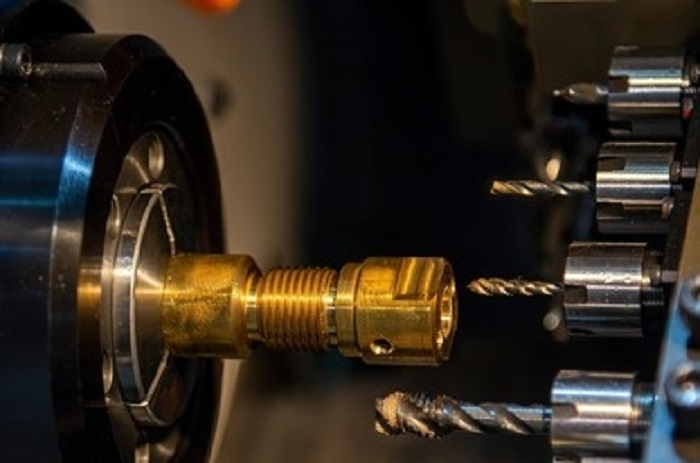
The demand for miniature-sized parts and devices with complex shapes and designs has gone up, and these requirements can be catered to efficiently via CNC Swiss machining. CNC turning and milling with Swiss machining technique enables the making of extremely tiny parts with tight tolerances. This is one reason Swiss machining services have gained immense traction over the years. This advanced machining technique creates the most intricate designs and complex geometries. Swiss machining has reshaped industries such as electronics, medical devices, aerospace engineering, and more. Are you intrigued to know more about this manufacturing technique? Continue reading this post to get all answers.
A Quick Introduction to CNC Swiss Machining
CNC Swiss machining is an advanced and efficient manufacturing technique that has refined how intricate parts are produced. This method gets its name after Switzerland’s tradition of watchmaking excellence. This machining technique is best suited for making small, intricate parts with tight tolerances. Its unique design, which incorporates a sliding headstock and a guide bushing, sets them apart from traditional machining. These elements offer exceptional stability, precision, and the ability to machine long, slender components. Combining advanced technology with traditional craftsmanship has become a cornerstone of modern manufacturing, delivering unparalleled precision and efficiency in producing critical components, and Swiss machining is an embodiment of this fusion.
Key Components and Mechanisms of CNC Swiss Machining
A CNC Swiss machine has several critical components that work together to achieve thin and slender parts with utmost precision.
- Sliding Headstock: The sliding headstock can hold and support the bar stock, which feeds into the machine. It offers controlled movement along the Z-axis, minimizing vibrations and ensuring precise cutting. This feature is essential for maintaining tight tolerances during the machining process.
- Guide Bushing: It supports the material being machined and helps reduce deflection and vibrations, ensuring precision for the most intricate and the smallest parts. Guide bushing is a hallmark of CNC Swiss machining and a key factor in achieving exceptional accuracy.
- Main Spindle and Sub-Spindle: The spindles are the most important component of CNC Swiss machining. Most machines are equipped with both main and sub-spindle. The main spindle holds the workpiece and rotates it during machining operations, while the sub-spindle is located opposite the main spindle. They enable “backworking,” where the part is handed off from the main spindle to the sub-spindle. This allows for operations on the opposite end of the workpiece without manual intervention.
- Tool Turret: The tool turret has several tools that can be rotated into position for drilling, cutting, milling, and threading operations without changing tools manually. Quick tool changes contribute to the efficiency of Swiss machining.
- Bar Feeder: As the name implies, a bar feeder can supply long bar stock to the machine. It feeds the material through the guide bushing. This allows continuous machining of multiple parts without an operator’s intervention. This automation plays a crucial role in high-volume production.
- Coolant System: These systems are important for removing chips from the cutting area and dissipating heat generated during machining. Effective coolant delivery enhances tool life, surface finish, and machining performance.
CNC Swiss Machining Benefits
Partnering with a CNC Swiss machining services provider offers several benefits, if you are an OEM that needs intricate and high-precision components in your final product. Here are some key advantages of opting for Swiss machining.
- Exceptional Precision: Combining the sliding headstock and guide bushing eliminates tool deflection, ensuring high accuracy and tight tolerance. Swiss machining is ideal for critical industries like aerospace and medical devices.
- Complex Geometry Handling: Swiss machines are designed to produce intricate and complex part geometries. This is crucial for aerospace, medical devices, and electronics industries, where components often have intricate features and there is zero tolerance for errors.
- Reduced Material Waste: These machines feature slender bar stock and efficient chip control, which minimizes material waste. This is crucial for expensive or hard-to-source materials.
- High Volume Production: The continuous use of multiple tools with backworking capabilities boosts overall production, making Swiss machining an efficient option for high-volume manufacturing.
- Wide Material Compatibility: This is another benefit of using these machines. Swiss machining can work well with several materials, including metals, plastics, and even challenging materials like titanium and super alloys, making it versatile for different industry needs.
- Reduced Setup Times: Once a Swiss machine is appropriately set up, it can run for extended periods with minimal operator intervention. This reduces downtime associated with frequent setups and tool changes.
- Cost-Effectiveness: Compared to traditional machining, the initial setup costs of Swiss machining are slightly higher. However, Swiss machining’s efficiency, reduced material waste, and high-quality output contribute to long-term cost savings.
Today, you can easily get Swiss machining services around you. However, not all guarantee quality or experience as they sound. Princeton Industrial Products, Inc. stands tall among its competitors. With years of market presence and expertise in making custom parts and products, the company has become a popular Swiss CNC machining service provider in the US. You can contact their team to discuss regarding their Swiss CNC machining services.



